Loading your own ammunition has advantages and disadvantages. There are many good reloading setups out there but it can be hard to decide which is best for you. Thankfully, you don’t need the latest, greatest, and most expensive press to produce high-quality ammunition. In fact, you don’t need a press at all. The Lee Classic Loader is the least expensive setup available. For over 70 years, it’s been the gateway into reloading for new reloaders.
The Lee Loader was my first reloading setup, and it remains one of my favorites. Follow along as we explore how to use both rifle and pistol Loader sets and test the reloaded ammunition for consistency and accuracy on the range.
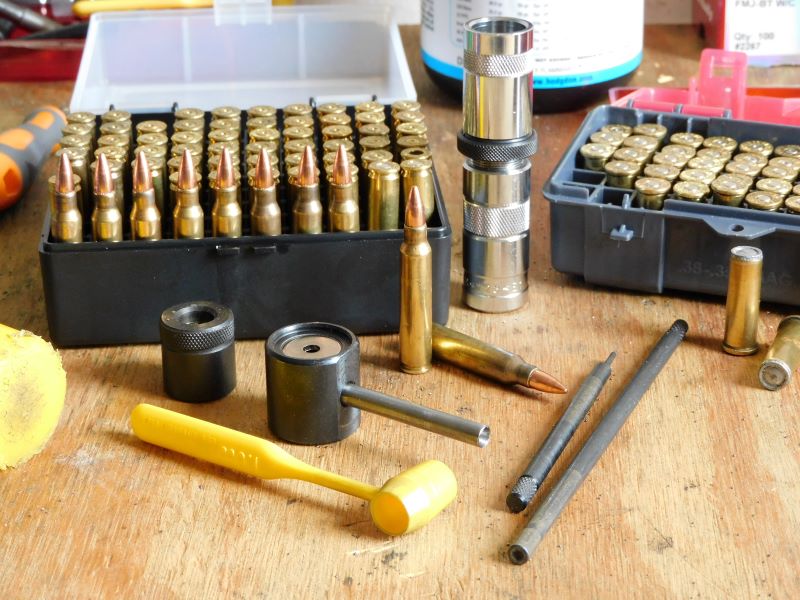
The Lee Loader: What’s In The Case
Lee Precision makes some of the most cost-effective reloading gadgets on the market. Richard Lee’s first product was his Lee Loader set. It included all that you need to roll your own ammunition minus components and a soft mallet. Over the years, the Lee Loader has been offered in numerous pistol and rifle calibers as well as all popular shotgun gauges. Today, you can get new Lee Loader pistol kits in 9mm Luger, .38 Special, .357 Magnum, .44 Magnum, .45 ACP, and .45 Colt. Rifle loaders are available in .223 Remington, .243 Winchester, .270 Winchester, .30-30, .303 British, 7.62x54R, .308 Winchester, .30-06, and .45-70.
Each kit comes with a variety of tools and accessories including a resizing die, a decapping chamber, a decapping rod, a primer/bullet seater, a capping rod, and a powder scoop. Pistol loaders come with a conical-shaped flaring tool. The Lee Loader set comes packed in a translucent red plastic case as well as an instruction manual and a load chart that shows how much powder the included scoop will measure by volume.
The Lee Classic Loader: Differences To Note
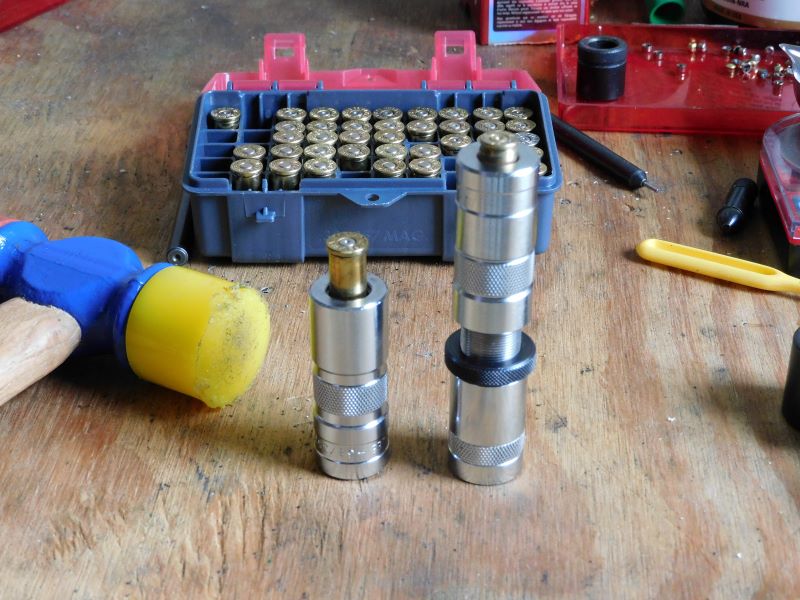
The pistol kit has a knurled locking collet on the bullet seater. Threading the seater rod back and forth and locking down the collet fixes bullet seating depth. The rifle kit’s collet is on the die itself and the two halves of the die are threaded apart to adjust seating depth.
All pistol dies fully resize the brass case from mouth to head, whereas the rifle dies only resize the neck of the case. It will require more force to fully seat and resize pistol brass, but you can use any pistol brass from any handgun. This will result in better potential accuracy, but the rest of the case is still fire-formed to a particular rifle. You will need to use brass fired from your particular rifle or use fresh factory cases. Fired brass from other rifles will only work in those specific rifles.
The Lee Loader In Practice
The Lee Loader kit is a much slower setup than a progressive press, but it requires no dedicated bench space and is only slightly slower than a single-stage press. With some technique, it is not unreasonable to load a box or two of ammo in the course of a few hours. You might make your ammunition through by repeating each step in the loading chain or by repeating each reloading process for all your cases before moving on to the next step.

Depriming and Resizing
The first step in using the Lee Loader kit is to knock out the dead primers in your empty cases. It is easiest to do with the rifle loader. Simply put your unresized brass in the decapping chamber, insert the decapping rod, and give it a smack with a plastic hammer. I find this process easier with pistol loaders while resizing the brass. Regardless, resizing is concurrent with depriming.

Resizing consists of pushing the case into the bottom of the die and striking it flush with the hammer. One hit is all that you need for rifle cases, but it can take a few whacks with pistol brass. Running case lube on the inside of the die or on the pistol cases can help.

Repriming
Once your case is seated in the die, drive it out with the capping rod. From this point, a new primer is in order. Insert a primer into the primer seater. The seater is spring-loaded and cushions the primer as you drive the case over it with your capping rod using light taps. Seating primers can be a nervous experience and requires the most technique out of all the steps to loading with the Lee Classic.
Hitting the case too hard can pop the primer, but you want to give it enough taps to fully seat the primer in the case. If you grip the decapping rod as you tap, you will feel movement as the primer seats and the dull thuds of the hammer will get sharp. That is when you are done, or close to it.
At any point until now, if you have a pistol die set, you can use the flaring tool on your empty cases. Insert the tapered end into the mouth of the case and give it a tap to flare the case to accept a bullet. Since the rifle loader resizes the neck already, this step is unnecessary for rifle cartridges.

Adding Powder
The next step in the loading process is to measure and put powder in each case. The Lee dipper included with each kit measures a theoretical amount of a given powder. If the scoop’s load data provides an acceptable load, it’s perfectly fine to use a leveled scoop of powder. But if the scoop meters out a load that is too light or too heavy, you can either change powders or get a set of scoops. A Lee scoop set is a faster option, but I ultimately chose a Hornady digital scale to measure most of my loads.
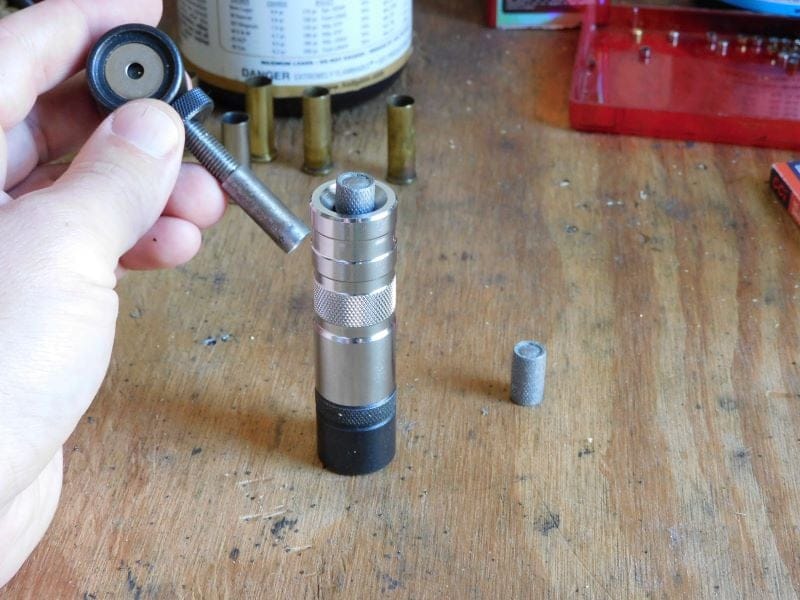
With the powder load worked out, set the primed case back on the decapping chamber with the resizing die on top. The top of the die acts as a funnel for you to pour powder in from the top. At this point, drop a projectile down from the top of the die, insert the bullet seater, and hit it with your hammer until the top of the seater stops at the top of the die. The bullet is now at the prescribed depth.
Bonus Tip: Crimping with the Lee Loader
Lee Precision recommends ammunition loaded with the Lee Classic Loader only be used in single-shot or bolt-action rifles. Lee does not make any specific disclaimers regarding the pistol kits. However, this warning exists because the Lee Loader doesn’t include a specifically dedicated crimp die.
A crimp die forms the case neck over the bullet to keep the bullet from moving out of or setting back into the case. For example, the spring pressure from a lever action rifle’s tubular magazine can cause bullet setback if the rounds aren’t crimped in place.

My first rifle reloads were with a Lee Loader in .30-30 Winchester. I stacked the ammunition into the tubular magazine of my lever-action ’94 Winchester and quickly unloaded the rifle. The ammunition was fine. But after I reloaded the rifle and left the ammunition in the tube for over a month, I found the bullets had setback in the cases slightly because of the spring pressure pushing on the rounds.
I quickly discovered both rifle and pistol loaders have a crimp tool of sorts. It’s a machined shelf at the top of the resizing die. For crimping, I take my freshly loaded ammunition, push it nose first into the top of the die, cushion the head of the case with the decapping chamber, and give the chamber a few light whacks. This is enough for a durable crimp, albeit not as precise as a dedicated crimp die.
The Lee Loader On The Range
The Lee Classic Loader is an easy to understand reloading device. However, it may not inspire the confidence you’d get from a sturdy press on a dedicated reloading bench. Some steps, like resizing and decapping, are sure and simple. Meanwhile, other procedures, like seating the primers and crimping the finished ammunition, require more patience.
As an outsider looking in, one has to ask just how good that ammunition really is. After all, how accurate can hammered together ammo be?
To put that question to the test, I spent a long afternoon hammering together ammunition with a pair of Lee Loaders — one in .38 Special and the other in .223 Remington. My .38 Special shells were loaded with Hornady 148-grain wadcutter bullets while I reloaded .223 with Hornady 55-grain BTFMJ projectiles.
Test Results?
I tested the consistency of both loads with five-round strings shot over my Caldwell Chronograph from 10 feet. For a bit of new vs. old contrast, I used my Smith & Wesson M&P 15 Sport II with a 16-inch barrel as my test platform for the .223 and a 1918-produced Smith & Wesson M&P revolver with a short barrel for the .38 Special.
The revolver’s wadcutter loads averaged 737 feet per second (FPS) with only a 48 FPS spread between the lowest and highest velocities. The rifle reloads averaged 3,028 FPS with a spread of 59 FPS. The Lee Loader can produce very consistent ammunition that cycled and ejected in both an elderly revolver and a modern AR platform.
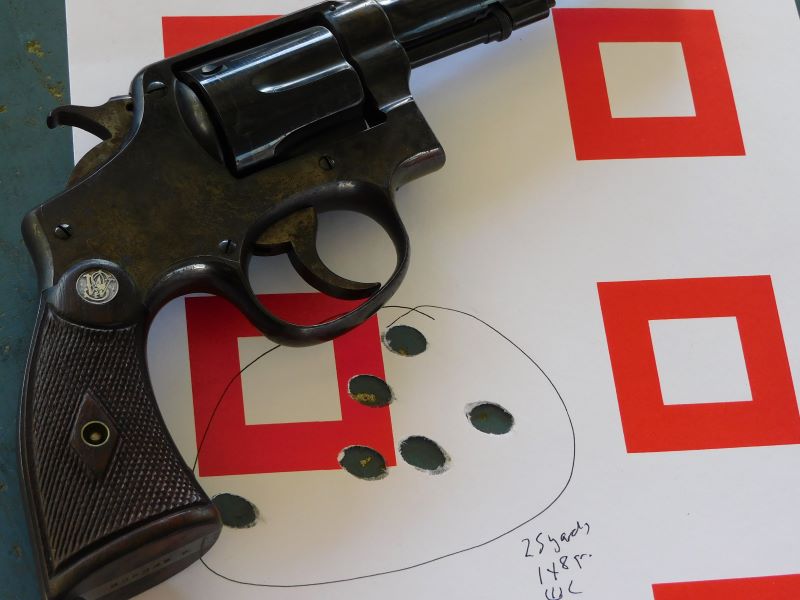
Next, I benched the pistol and fired a series of six-round groups at a paper target posted at 25 yards. The target broke over in the wind and my rounds struck angularly, but my groups at that distance were respectable. My best effort put six rounds into a 1.75-inch cluster.
After expending my .38 Special ammo, I turned back to the Sport II, stacked the magazine with .223 reloads, and posted five-round groups at 100 yards. While a high-powered scope would be ideal for maximum accuracy, I worked with the Primary Arms 3x SLR microprism sight I keep on it.
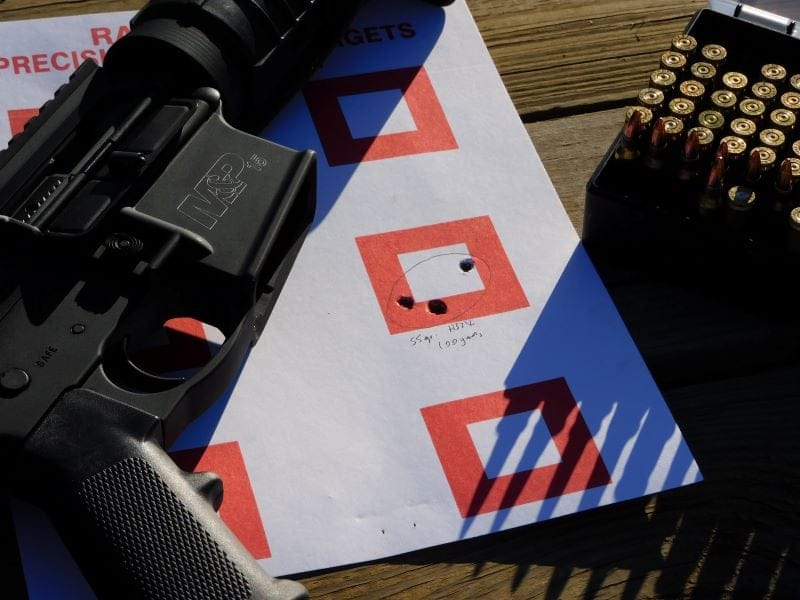
Despite the low magnification, I picked out a definitive aiming point and posted my groups inside two inches reliably. My best effort was to put five rounds into 1.25 inches. With most factory 55-grain ammunition, the Sport II is a three-inch grouping rifle. The reloads paid dividends.
The Lee Classic Loader: Should You Buy It?
After 12 years of use and thousands of rounds loaded, I’ve become familiar with the Lee Loader’s merits and demerits. Since then, reloading setups are bigger and more monstrous as well as smaller and more accessible to the average shooter. I have a few Lee Loader sets and I have no plans to get rid of them. I keep mine around and Lee Precision keeps selling them because it expressly does what it claims to do.
With the Lee Classic Loader, the game is quality over quantity. This minimalist kit is quick enough to get you into reloading. Meanwhile, the intimately-involved and slow loading process prevents common mistakes. High-volume shooters won’t be satisfied. However, the majority of us who want to crank out a box or two for a shooting session or hunting season, the Lee Loader is still hard to beat.

